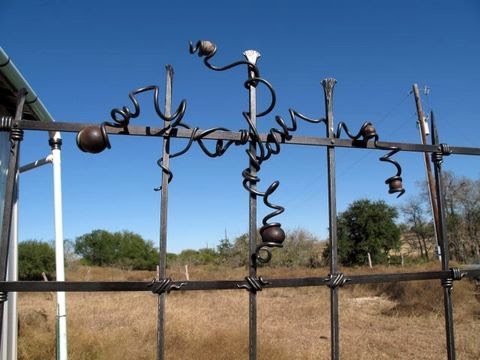Bracelets
I forge bracelets out of different sizes and shapes of mild steel bar stock. The ends are tapered, rounded, and/or flattened first. I may also flatten round stock or square stock on the diamond. If I am going to file or fuller the edges, I do it after working the ends. Then, I do my twisting, securing the piece in the vice and spot heating in small increments with a torch and working my way up with a twisting wrench. After the twists are done, I shape the bracelet over the horn of the anvil, using a wooden mallet, so as not to damage the twist. Of course, if I decide to flatten the twist, I use my forging hammer. The final step is any scrolling done to the ends, which I do using scrolling pliers. I normally just apply Johnson's Paste Wax or Renaissance Wax to the heated bracelet after going over it with a wire wheel.
Napkin Rings
The napkin rings I make are for use with large, cloth napkins. I like to use 1/4" round or 3/16" square bar. I begin by heating the stock in the forge and tapering the ends. If I'm using square stock, I also flatten the ends on the diamond into a spear point. I use a torch to spot heat and create whatever twist I'm using at this point. Then, I heat the whole piece in the forge and wrap it around a jig made from a piece of pipe. When all of the rings are made, I clamp each one onto the jig and use scrolling pliers to scroll the ends. Finally, they are wire-wheeled and sprayed with Krylon Clear Satin Acrylic coating.
Earring Tree
I made the earring tree because I had a dresser top full of earrings to organize. I used 1/4" square bar for this project. I cut a starting length that would allow me to have two separate places to hang earrings on, each supported on a different height vertical section coming up from an "S"-shaped base. I used the propane forge to heat each end and then tapered them to a square point. The earring-hanger sections were then flattened on the diamond so that the earrings would fit over them. Each end was then bent straight up, leaving material in the middle to be bent into a stand. A twist was put in each vertical piece starting one inch from the bottom and ending one inch from the top. Then, the base was curved into a stand. Finally, the sections for the earrings were bent into organic forms. The tree was wire wheeled, heated and waxed with Renaissance Wax. Turns out that my sister needed an earring tree worse than I did, so she got this one and I made another one for myself.
Detail of Earring Tree






















